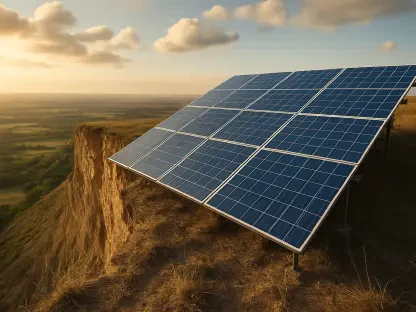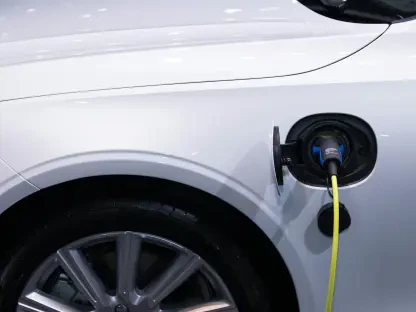In a world increasingly desperate for sustainable solutions to combat climate change, a remarkable advancement in magnet technology has emerged as a potential game-changer for green energy. Researchers from the Daegu Gyeongbuk Institute of Science and Technology in Korea have unveiled a pioneering method that could significantly lower the costs and boost the efficiency of critical eco-friendly technologies. This innovation focuses on high-performance permanent magnets, vital components in wind turbines and electric vehicle (EV) motors, which play a pivotal role in reducing dependence on fossil fuels. By addressing long-standing challenges in magnet production, this development promises to make clean energy systems more accessible and effective, potentially accelerating the global transition to a greener future. The implications of this breakthrough extend beyond technical achievement, offering hope for mitigating the environmental damage caused by heat-trapping emissions linked to extreme weather events.
Revolutionizing Green Technology
Enhancing Magnet Performance for Sustainability
The core of this technological leap lies in a novel manufacturing process that ensures uniform distribution of rare-earth metals throughout permanent magnets, rather than limiting them to surface coatings. Traditional methods, such as grain boundary diffusion, often resulted in inconsistent performance, particularly at higher temperatures, necessitating expensive materials to maintain functionality. This new approach overcomes those limitations, delivering magnets that perform reliably across their entire structure. Such consistency is crucial for applications in wind turbines and EV motors, where efficiency directly impacts energy output and range. By improving performance without relying heavily on costly resources, this method paves the way for more affordable green technologies, potentially transforming industries that are central to reducing carbon footprints and combating the escalating effects of climate change.
Driving Miniaturization and Efficiency
Beyond performance, this innovation opens doors to significant design improvements in sustainable technologies. With magnets that maintain strength and reliability, manufacturers can explore miniaturization and weight reduction in devices, leading to more compact and efficient systems. For instance, smaller, lighter EV motors could extend vehicle range while reducing energy consumption, making electric transportation more appealing to consumers. Similarly, streamlined wind turbine components could lower installation and maintenance costs, encouraging broader adoption of renewable energy sources. This shift not only enhances the practicality of green solutions but also aligns with global efforts to curb emissions from fossil fuel reliance. The potential for such advancements underscores the far-reaching impact of improved magnet technology on both environmental goals and economic viability in the clean energy sector.
Broader Impacts on a Greener Future
Supporting a Circular Economy in Green Tech
An often-overlooked benefit of this magnet technology breakthrough is its alignment with the principles of a circular economy. The ability to recover rare-earth metals from used magnets, as well as extract magnets from retired EV batteries, presents a sustainable pathway for resource management. This recycling potential reduces the demand for virgin materials, which are both scarce and expensive, thereby lowering production costs and environmental impact. Additionally, integrating recycled materials into new magnets supports the scalability of green technologies by ensuring a steady supply of critical components. As industries like wind power and electric transportation grow, such practices could become a cornerstone of sustainable manufacturing, reinforcing efforts to minimize waste and preserve natural resources while addressing the urgent need to transition away from polluting energy sources.
Accelerating the Fight Against Climate Change
The significance of enhanced magnet technology extends to its role in mitigating the devastating effects of climate change. Wind power and EVs are pivotal in reducing reliance on gasoline, coal, and oil, which release emissions contributing to worsening droughts, floods, and heatwaves. By improving the efficiency and affordability of these systems, the new manufacturing method empowers industries to scale up clean energy adoption at a faster pace. This progress is vital for improving quality of life, as it lessens the economic and ecological burdens of extreme weather events. Principal researcher Donghwan Kim emphasized that this advancement marks a crucial step forward, with the potential to revolutionize sustainable energy applications. The eagerness to see this innovation implemented in real-world settings reflects a shared commitment to harnessing technology for environmental protection and societal benefit.
Paving the Way Forward
Reflecting on a Milestone Achievement
Looking back, the strides made by the Korean research team in magnet technology stand as a testament to human ingenuity in the face of environmental challenges. Their method of uniformly infusing rare-earth metals into permanent magnets addresses critical performance inconsistencies that had long hindered progress in green energy systems. This achievement not only enhances the reliability of wind turbines and EV motors but also reduces dependence on costly materials, setting a new standard for sustainable innovation. The dedication to overcoming technical barriers highlights the potential for science to drive meaningful change, offering a blueprint for future advancements in clean energy solutions that prioritize both efficiency and accessibility.
Charting the Next Steps for Implementation
As attention turns to the future, the focus must shift to translating this groundbreaking research into practical applications across industries. Stakeholders in renewable energy and electric transportation should prioritize partnerships to integrate these advanced magnets into existing systems, testing their impact on a broader scale. Simultaneously, investment in recycling infrastructure will be essential to maximize the benefits of a circular economy, ensuring that rare-earth materials are reused effectively. Policymakers and industry leaders must also collaborate to create incentives that accelerate the adoption of these technologies, reinforcing global commitments to reducing emissions. By building on this foundation, the path toward a more sustainable and energy-efficient world becomes clearer, promising lasting benefits for both the planet and its inhabitants.









